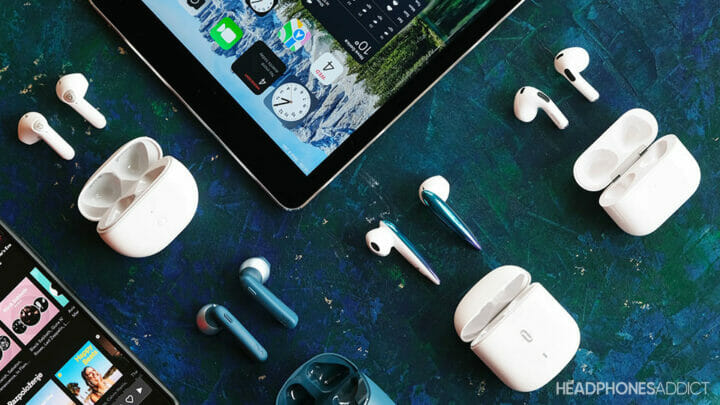IEMs and earbuds look similar but differ in one crucial way. This article will help you clarify all the differences between the 2 types of in-ear headphones.
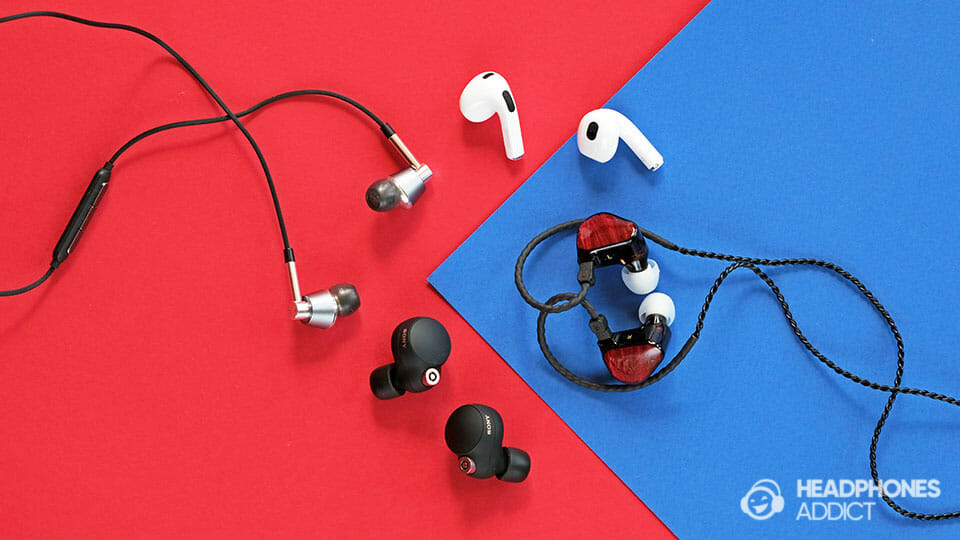
- The main difference between IEMs (in-ear monitors) and earbuds is that IEMs are used by musicians for stage monitoring and audiophiles for critical listening. And earbuds are used for casual listening.
Earbuds is the term for all in-ear headphones. However, to better differentiate between earbuds for different jobs, we now separate them into IEMs and earbuds/earphones.
- IEMs are wired in-ear earbuds designed for musicians and stage monitoring. They offer a neutral sound signature, an ear canal seal, and great stability.
- Earbuds represent consumer-focused in-ear headphones: True wireless earbuds with in-ear OR non-in-ear fit (also called earphones, like Apple AirPods 3).
Different people understand the terms differently. And they’re always evolving.
You might encounter the term earbuds used to only describe non-in-ear earphones, with TWS earbuds falling into “wireless IEM” territory. But for the purpose of this article, we are sticking to the explanation stated above.
So when somebody mentions in-ear monitors or IEMs, they probably mean wired in-ear headphones for professional monitoring, audiophiles, and audio engineers.
IEMs vs. Earbuds: A Detailed Comparison
While both types of headphones fall into the in-ear headphones category, they serve a completely different purpose.
Let’s look at the differences between the 2 types.
Pros & cons of IEMs
- Full, neutral frequency response
- Greater passive noise isolation
- Stable fit
- Customizable fit with different types of ear tips
- Made from luxurious materials
- More expensive
- not all find in-ear fit comfortable
- Not as breathable
- Light on features
Pros & cons of earbuds
- Various sound signatures for all tastes
- Rich with extra features
- Better protected against water or dust (if Bluetooth)
- Typically cheaper
- Overall worse sound quality
- Not as solid passive isolation
- Not suitable for professional work
Sound quality
Sound quality is one area where average consumer earbuds can’t match IEMs. Some models come pretty close, like Sony WF-1000XM4, but there’s still a lot of room for improvement.
IEMs sound quality
- IEMs can deliver a tighter bass response that you can further improve by using stronger headphone amps.
- Manufacturers of high-end IEMs equip them with better drivers, typically resulting in higher resolution and detail retrieval.
- Sound from the IEMs is also more impactful, realistic (although not quite as prominent as with over-ear headphones), and more dynamic.
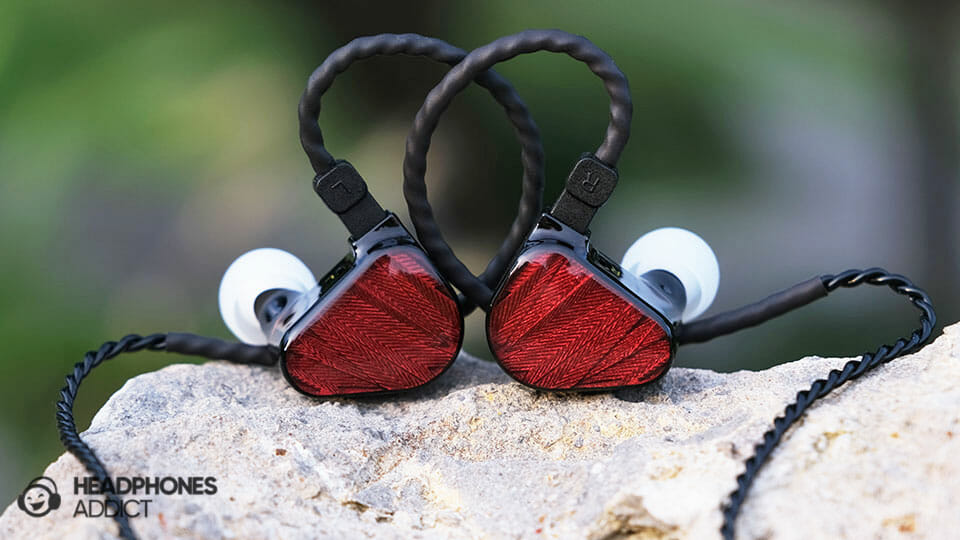
Earbuds sound quality
- Earbuds can sound really good, offering various sound signatures, from skull-rattling bass to neutral or bright.
- Earphone types are light on bass extension and typically have less detailed sound.
- Some true wireless earbuds require built-in amps and DACs and heavily rely on DSPs, which are normally lower quality and less capable than the ones found in phones, computers, etc.

Comfort and fit
IEMs and earbuds are overall equally comfy, with some designs fitting better than others. Even stability tends to be fairly equal between the two, so it all comes down to personal preference.
IEM comfort
- In-ear monitors are overall very comfy. However, some have strange designs that can poke in your pinna and cause an ache (like CCA LYRA did to us).
- The in-ear fit of universal IEMs is something you need to get used to, as some find it a bit intrusive. It can cause ear canal pressure, which can be annoying or even painful.
- Using cheap ear tips and foam tips with a rough surface can scratch the skin in your ear canal, leading to potential infection.
- Many audiophile IEMs require you to wear them with the cable behind the ear, significantly improving stability.
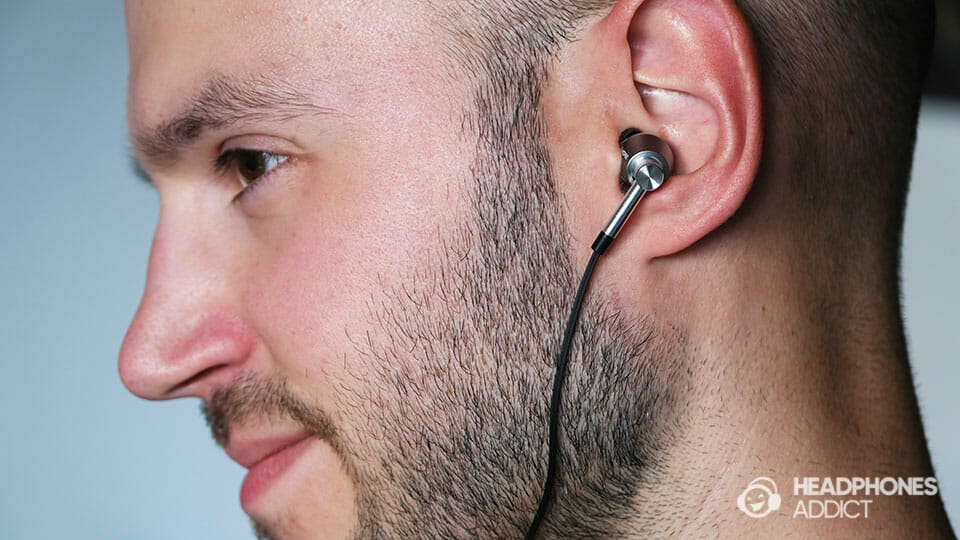
Earbuds’ comfort
- Earphones (without ear tips) have a less intrusive design, making them generally comfier and lighter.
- Hanging in your outer ear without entirely blocking the ear canal, earbuds allow the air to circulate. Fun fact: your head is also cooling through ear canals, so you sweat more if you block them.
- A downside of simply “hanging in your pinna” means they provide minimal friction with the skin, resulting in poor stability. Apart from walking, they’re unsuitable for other sports.
- True wireless earbuds with ear tips have much better stability than earphones. The ones with foam ear tips, ear fins, or hooks have the most stable fit and are suitable for sports (as seen in the best workout earbuds).
- On the flip side, having to store many components, TWS buds can be bulky, so your ears need to be compatible with their shape to offer the best comfort.
Noise isolation
You achieve passive noise isolation by blocking your ears. Without the proper seal, you can hear all the ambient noise around you.
IEMs isolation
- With different types of replaceable ear tips (especially multi-flanged), IEMs provide superior noise isolation.
- The effectiveness of the isolation comes down to the insertion depth, type of ear tip, and overall construction (metal is typically better at isolation than plastic).
Earbuds isolation
- Non-in-ear earphones marginally block the ear canal, allowing the outside noise to pass through. Some models better block ambient noise than others, but you can always hear what’s happening around you, even when playing music.
- Many true wireless earbuds offer active noise cancellation. It improves noise isolation by also reducing low-frequency hum with ANC.
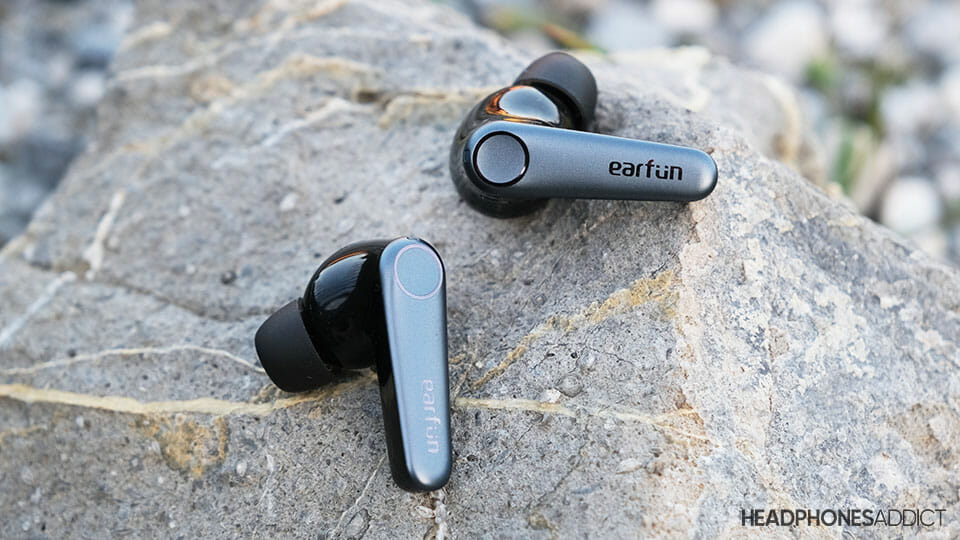
Application and usage
All of the characteristics mentioned under the titles above impact how you can use IEMs or earbuds.
IEM application & usage
- Thanks to a more natural/neutral sound, they’re a better choice for audio production and audiophiles.
- Better passive isolation means they’re ideal for musicians and stage audio monitoring.
- While they have a very stable fit, they normally lack an IPX rating, making them unsuitable for sports activities.
Earbuds‘ application & usage
- Having a less refined but still enjoyable sound, they’re great for casual listening.
- Earphones’ lack of efficient passive isolation can be an advantage when using them outdoors, as you can hear potential dangers like passing cars.
- TWS earbuds’ ability to have multiple features like ANC, ambient sound mode, app, and multipoint (and a lack of wires) makes them a fantastic choice for commuting and multitasking.
- Most earbuds (true wireless ones) have an IPX rating, which makes them at least sweatproof. Consequently, you can use them in harsher environments like outdoors or in the gym.
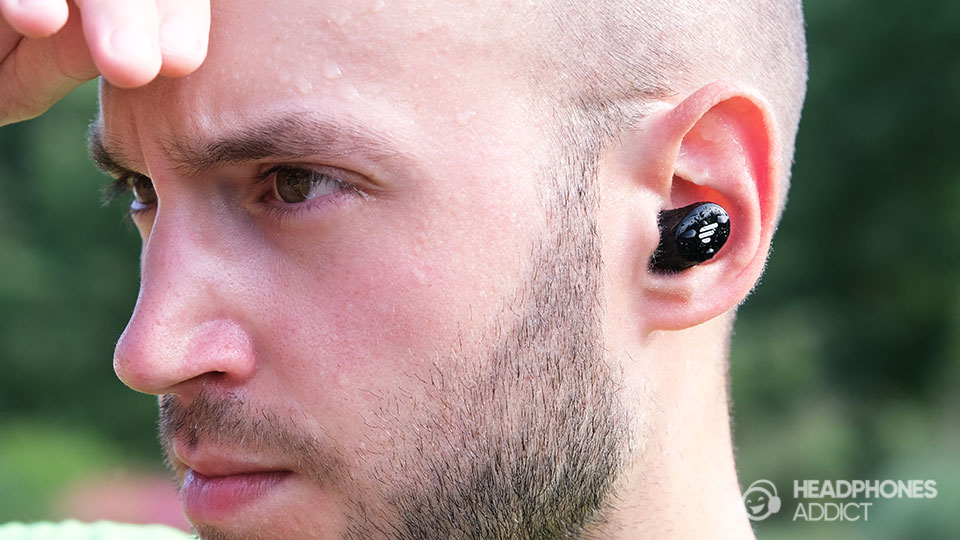
Features & technology
Overall, IEMs have much fewer features than earbuds, with one similarity:
- Built-in microphones for making calls (a feature that’s mostly optional)
But earbuds offer more:
- Companion app
- Active noise cancelling (ANC)
- Customizable controls
- Customizable equalizer
- Game mode
- Bluetooth multipoint
- Various Bluetooth versions
- Various Bluetooth codecs
- Fast and Qi wireless charging
- Automatic play/pause sensor
- Spatial audio
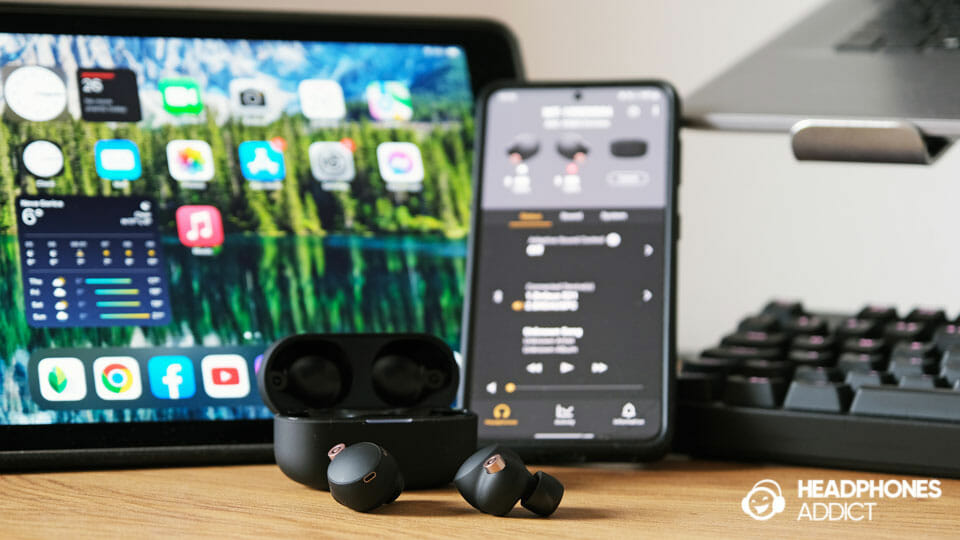
That said, different physical characteristics mean that some features can only work (effectively) in a specific type of in-ear headphones. This means that due to design, earphones lack ANC and transparency mode.
Driver types
Interestingly, you won’t find all the driver types in earbuds. But you can find them in IEMs.
It comes down to manufacturers unwilling to invest in making expensive earbuds that few will buy. Also, some driver types (like electrostatic) require more power to run properly, which would eat up the battery life.
Here are all the potential drivers you can find in the two types of in-ear headphones:
IEM: In-ear monitor driver types
- Dynamic drivers
- Balanced armature
- Planar magnetic
- Piezoelectric
- Electrostatic

Earbud driver types
- Dynamic driver
- Balanced armature
Pricing
IEMs have various designs and can use different build materials and driver types. All of that raises the price. That said, you can get IEMs at all price ranges, from below $10 to more than $10,000 (oBravo Ra-c-cu (21.5) cost almost $11,000).
On the other hand, earbuds are primarily plastic and only utilize dynamic or balanced armature drivers. They can still reach a high price of around $500 (HIFIMan SVANAR), but not close to high-end IEMs.
What are IEMs?
IEMs or “in-ear monitors” are wired in-ear headphones that use ear tips that plug into your ear canal. Their main job is to ensure a stable fit, excellent passive isolation, and natural sound.
Having a cable wired over the ear helps to better distribute the weight, reduce microphonics, and ensure much better stability.
Technically, even true wireless earbuds can be classified as IEMs (if they have ear tips). However, they can’t be used for monitoring due to unreliable connection.

Wired design is the biggest advantage that IEMs have over wireless solutions. It means that manufacturers can fit bigger and more drivers into smaller enclosures since there are no batteries and electronic chips to take up space.
Furthermore, IEMs use external amplification and signal processing, which is typically higher quality than the ones built into wireless earbuds. That also ensures performance scalability (a better amp can yield better sound performance).
How we name different in-ear headphone designs on HeadphonesAddict
To avoid excessive wording and constant explanations about whether we mean earbuds with or without eartips, we agree to use the following classifications:
- IEMs are wired in-ear headphones that use ear tips.
- Earbuds are wired or wireless in-ear headphones that use ear tips.
- (Classic) earphones are non-in-ear earbuds that don’t have ear tips but sit outside the ear canal instead.

History and evolution of IEMs
As the word “monitor” suggests, IEMs’ original job was to help musicians monitor their performance during live performances. They’re still using them for this exact job.
Unsurprisingly, the natural/neutral tuning caught the attention of audiophiles, so manufacturers started making more luxurious IEM versions.
Originally, IEMs needed to offer excellent passive isolation, stability, and neutral/natural sound signature. In contrast, modern IEMs come in a variety of signatures.
Today, the term “IEM” is primarily used in the professional and audiophile community.
What are Earbuds?
Earbuds are all in-ear headphones (except for wired IEMs) that you typically use for casual, everyday listening. Earbuds can be:
- In-ears with ear tips, like true wireless earbuds.
- In-ears without ear tips, like classic earphones.
Their main characteristics are affordability, ease of use (they work well with all portable devices), and additional features for enhanced user experience, like a built-in mic, ANC, voice assistant, etc.

History and evolution of earbuds
The first earbuds were invented in 1891 to free telephone operators’ hands while taking notes from callers. Learn more about the history of headphones.
However, it was in the 1950s that people started using the first (mono) earphones to listen to music.
Earbuds and earphones were frequently bundled with new cellular phones and handed for free in museums or tourist buses to listen to the guide.
They’re still considered best used for casual rather than analytical listening or professional work.
Related:
Frequently Asked Questions (FAQ)
Are IEMs better than earbuds?
IEMs are better than earbuds in audio quality. Otherwise, earbuds tend to be more affordable and richer in features, making them a much better pick for casual users.
Do IEMs have better sound quality?
IEMs have better sound quality than earbuds since they have a more natural sound signature and tend to use higher-quality drivers.
Are IEMs safer than earbuds?
IEMs aren’t safer than earbuds since they don’t let you hear potential dangers nearby. Also, ear tips can scratch the ear canal, leading to infections.
Can IEMs be used as earphones?
IEMs can’t be used as earphones, or at least it wouldn’t make sense to use them as such. IEMs require ear tips to work optimally, whereas earphones don’t have ear tips.
Why do audiophiles like IEMs?
Audiophiles like IEMs over earbuds since they provide a fuller, more neutral sound. Manufacturers also make IEMs with various driver types and configurations to perfect the audio performance.
Why are IEMs so expensive?
IEMs are expensive because manufacturers must carefully design tiny housing and even tinier drivers that produce an expansive, dynamic sound. The price goes up when implementing more luxurious materials.
Do IEMs cancel noise?
IEMs don’t cancel noise; they block it. There’s a difference between active cancellation, which eliminates noise by creating a counter noise, and passive isolation, which uses dampening to lower the loudness of the noise.
Conclusion
In-ear monitors and earbuds might fall into the same in-ear headphones category, but they serve a completely different purpose. To recap:
- IEMs are for musicians and audiophiles looking for neutral tuning and stable fit, regardless of the price.
- Earbuds target a wider audience with their affordability and attractive sets of extra features.
While IEMs have better audio quality, they also cost more and require you to have slightly better audio equipment (amp, DAC) to run them optimally. Which means they offer a poor value for a non-demanding user.
- Still, if you want the best audio quality, check out the best in-ear monitors on the market.
On the other hand, earbuds still sound good enough and also shower you with quality-of-life features (at least true wireless ones).
- See our guide for the best classic earphones, or go with in-ear fit and more features with the best ANC earbuds.

From a childhood fascination with sound, Peter’s passion has evolved into a relentless pursuit of the finest headphones. He’s an audio expert with over 5 years of experience in testing both audiophile and consumer-grade headphones. Quote: “After many years, I can confidently tell which headphones are good and which are terrible.” Find his honest opinion in his reviews.


